Smite's new Conquest map revealed

The first Smite World Championship marks the beginning of the game's life as a major e-sport, but is also - it turns out - a swansong for the map currently being used for competitive play. After the tournament, Smite Season 2 will begin in earnest. It's a program of tournaments, updates and new releases that will change the shape of the game over the course of the coming year.
The most significant of these changes is close. In January, an overhauled version of the game's key three-lane Conquest map will be released onto the public test server.
The first thing you'll notice is the extensive work done to expand the scope of the game beyond the playable area. The backdrops for both teams' bases are now far more dramatic. Rather than being painted onto the skybox, Chaos' volcano looms over the battlefield, spilling lava into the playable area. Mount Olympus, likewise, is now less ornamental garden and more Arcadian metropolis - even though the playable space only extends so far, it has a much stronger sense of being a real place.
What has impressed me, checking out the new map for the first time, is how it makes use of Smite's third person camera. You can't do vistas like this in League of Legends or Dota 2 - the new long lane, for example, looks out over a bay patrolled by distant Greek longships. Likewise, the map's special neutral monsters, the Gold Fury and the Fire Giant, will now make dramatic entrances when they spawn. In the Fire Giant's case, this means fighting his way out of a stone prison. The Harpy, however, flies in from the heights of Olympus passing several other objectives as she goes. You couldn't do that in an isometric game without impacting game balance.
There are, however, a few major changes in the pipeline. Not all of the details are available yet, but there'll be changes to the regular buff camps that sound like they'll make the map slightly more symmetrical - potentially negating the perceived Chaos advantage. 'Leashing', the practise of drawing neutral monsters out of their camps, has been substantially altered also. Resetting a neutral encounter by running away will no longer instantly reset the monsters' health bars. Instead, they'll regen slowly over time. This means that abandoning a Gold Fury attempt risks leaving the job for the enemy team to finish. Crucially, this change will impact every mode that includes neutral monsters.
The new map is due to be available for public testing around the 17th of January.
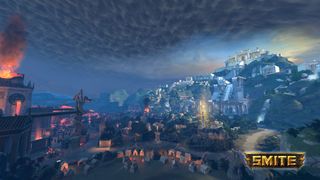
The first Smite World Championship marks the beginning of the game's life as a major e-sport, but is also - it turns out - a swansong for the map currently being used for competitive play. After the tournament, Smite Season 2 will begin in earnest. It's a program of tournaments, updates and new releases that will change the shape of the game over the course of the coming year.
The most significant of these changes is close. In January, an overhauled version of the game's key three-lane Conquest map will be released onto the public test server.
The first thing you'll notice is the extensive work done to expand the scope of the game beyond the playable area. The backdrops for both teams' bases are now far more dramatic. Rather than being painted onto the skybox, Chaos' volcano looms over the battlefield, spilling lava into the playable area. Mount Olympus, likewise, is now less ornamental garden and more Arcadian metropolis - even though the playable space only extends so far, it has a much stronger sense of being a real place.
What has impressed me, checking out the new map for the first time, is how it makes use of Smite's third person camera. You can't do vistas like this in League of Legends or Dota 2 - the new long lane, for example, looks out over a bay patrolled by distant Greek longships. Likewise, the map's special neutral monsters, the Gold Harpy and the Fire Giant, will now make dramatic entrances when they spawn. In the Fire Giant's case, this means fighting his way out of a stone prison. The Harpy, however, flies in from the heights of Olympus passing several other objectives as she goes. You couldn't do that in an isometric game without impacting game balance.
There are, however, a few major changes in the pipeline. Not all of the details are available yet, but there'll be changes to the regular buff camps that sound like they'll make the map slightly more symmetrical - potentially negating the perceived Chaos advantage. 'Leashing', the practise of drawing neutral monsters out of their camps, has been substantially altered also. Resetting a neutral encounter by running away will no longer instantly reset the monsters' health bars. Instead, they'll regen slowly over time. This means that abandoning a Gold Fury attempt risks leaving the job for the enemy team to finish. Crucially, this change will impact every mode that includes neutral monsters.
The new map is due to be available for public testing around the 17th of January.

The first Smite World Championship marks the beginning of the game's life as a major e-sport, but is also - it turns out - a swansong for the map currently being used for competitive play. After the tournament, Smite Season 2 will begin in earnest. It's a program of tournaments, updates and new releases that will change the shape of the game over the course of the coming year.
The most significant of these changes is close. In January, an overhauled version of the game's key three-lane Conquest map will be released onto the public test server.
The first thing you'll notice is the extensive work done to expand the scope of the game beyond the playable area. The backdrops for both teams' bases are now far more dramatic. Rather than being painted onto the skybox, Chaos' volcano looms over the battlefield, spilling lava into the playable area. Mount Olympus, likewise, is now less ornamental garden and more Arcadian metropolis - even though the playable space only extends so far, it has a much stronger sense of being a real place.
What has impressed me, checking out the new map for the first time, is how it makes use of Smite's third person camera. You can't do vistas like this in League of Legends or Dota 2 - the new long lane, for example, looks out over a bay patrolled by distant Greek longships. Likewise, the map's special neutral monsters, the Gold Harpy and the Fire Giant, will now make dramatic entrances when they spawn. In the Fire Giant's case, this means fighting his way out of a stone prison. The Harpy, however, flies in from the heights of Olympus passing several other objectives as she goes. You couldn't do that in an isometric game without impacting game balance.
There are, however, a few major changes in the pipeline. Not all of the details are available yet, but there'll be changes to the regular buff camps that sound like they'll make the map slightly more symmetrical - potentially negating the perceived Chaos advantage. 'Leashing', the practise of drawing neutral monsters out of their camps, has been substantially altered also. Resetting a neutral encounter by running away will no longer instantly reset the monsters' health bars. Instead, they'll regen slowly over time. This means that abandoning a Gold Fury attempt risks leaving the job for the enemy team to finish. Crucially, this change will impact every mode that includes neutral monsters.
The new map is due to be available for public testing around the 17th of January.
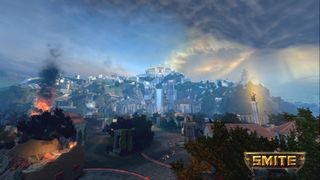
The first Smite World Championship marks the beginning of the game's life as a major e-sport, but is also - it turns out - a swansong for the map currently being used for competitive play. After the tournament, Smite Season 2 will begin in earnest. It's a program of tournaments, updates and new releases that will change the shape of the game over the course of the coming year.
The most significant of these changes is close. In January, an overhauled version of the game's key three-lane Conquest map will be released onto the public test server.
The first thing you'll notice is the extensive work done to expand the scope of the game beyond the playable area. The backdrops for both teams' bases are now far more dramatic. Rather than being painted onto the skybox, Chaos' volcano looms over the battlefield, spilling lava into the playable area. Mount Olympus, likewise, is now less ornamental garden and more Arcadian metropolis - even though the playable space only extends so far, it has a much stronger sense of being a real place.
What has impressed me, checking out the new map for the first time, is how it makes use of Smite's third person camera. You can't do vistas like this in League of Legends or Dota 2 - the new long lane, for example, looks out over a bay patrolled by distant Greek longships. Likewise, the map's special neutral monsters, the Gold Harpy and the Fire Giant, will now make dramatic entrances when they spawn. In the Fire Giant's case, this means fighting his way out of a stone prison. The Harpy, however, flies in from the heights of Olympus passing several other objectives as she goes. You couldn't do that in an isometric game without impacting game balance.
There are, however, a few major changes in the pipeline. Not all of the details are available yet, but there'll be changes to the regular buff camps that sound like they'll make the map slightly more symmetrical - potentially negating the perceived Chaos advantage. 'Leashing', the practise of drawing neutral monsters out of their camps, has been substantially altered also. Resetting a neutral encounter by running away will no longer instantly reset the monsters' health bars. Instead, they'll regen slowly over time. This means that abandoning a Gold Fury attempt risks leaving the job for the enemy team to finish. Crucially, this change will impact every mode that includes neutral monsters.
The new map is due to be available for public testing around the 17th of January.

The first Smite World Championship marks the beginning of the game's life as a major e-sport, but is also - it turns out - a swansong for the map currently being used for competitive play. After the tournament, Smite Season 2 will begin in earnest. It's a program of tournaments, updates and new releases that will change the shape of the game over the course of the coming year.
The most significant of these changes is close. In January, an overhauled version of the game's key three-lane Conquest map will be released onto the public test server.
The first thing you'll notice is the extensive work done to expand the scope of the game beyond the playable area. The backdrops for both teams' bases are now far more dramatic. Rather than being painted onto the skybox, Chaos' volcano looms over the battlefield, spilling lava into the playable area. Mount Olympus, likewise, is now less ornamental garden and more Arcadian metropolis - even though the playable space only extends so far, it has a much stronger sense of being a real place.
What has impressed me, checking out the new map for the first time, is how it makes use of Smite's third person camera. You can't do vistas like this in League of Legends or Dota 2 - the new long lane, for example, looks out over a bay patrolled by distant Greek longships. Likewise, the map's special neutral monsters, the Gold Harpy and the Fire Giant, will now make dramatic entrances when they spawn. In the Fire Giant's case, this means fighting his way out of a stone prison. The Harpy, however, flies in from the heights of Olympus passing several other objectives as she goes. You couldn't do that in an isometric game without impacting game balance.
There are, however, a few major changes in the pipeline. Not all of the details are available yet, but there'll be changes to the regular buff camps that sound like they'll make the map slightly more symmetrical - potentially negating the perceived Chaos advantage. 'Leashing', the practise of drawing neutral monsters out of their camps, has been substantially altered also. Resetting a neutral encounter by running away will no longer instantly reset the monsters' health bars. Instead, they'll regen slowly over time. This means that abandoning a Gold Fury attempt risks leaving the job for the enemy team to finish. Crucially, this change will impact every mode that includes neutral monsters.
The new map is due to be available for public testing around the 17th of January.
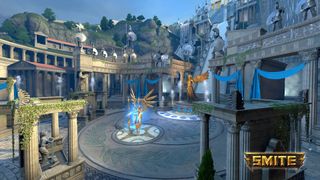
The first Smite World Championship marks the beginning of the game's life as a major e-sport, but is also - it turns out - a swansong for the map currently being used for competitive play. After the tournament, Smite Season 2 will begin in earnest. It's a program of tournaments, updates and new releases that will change the shape of the game over the course of the coming year.
The most significant of these changes is close. In January, an overhauled version of the game's key three-lane Conquest map will be released onto the public test server.
The first thing you'll notice is the extensive work done to expand the scope of the game beyond the playable area. The backdrops for both teams' bases are now far more dramatic. Rather than being painted onto the skybox, Chaos' volcano looms over the battlefield, spilling lava into the playable area. Mount Olympus, likewise, is now less ornamental garden and more Arcadian metropolis - even though the playable space only extends so far, it has a much stronger sense of being a real place.
What has impressed me, checking out the new map for the first time, is how it makes use of Smite's third person camera. You can't do vistas like this in League of Legends or Dota 2 - the new long lane, for example, looks out over a bay patrolled by distant Greek longships. Likewise, the map's special neutral monsters, the Gold Harpy and the Fire Giant, will now make dramatic entrances when they spawn. In the Fire Giant's case, this means fighting his way out of a stone prison. The Harpy, however, flies in from the heights of Olympus passing several other objectives as she goes. You couldn't do that in an isometric game without impacting game balance.
There are, however, a few major changes in the pipeline. Not all of the details are available yet, but there'll be changes to the regular buff camps that sound like they'll make the map slightly more symmetrical - potentially negating the perceived Chaos advantage. 'Leashing', the practise of drawing neutral monsters out of their camps, has been substantially altered also. Resetting a neutral encounter by running away will no longer instantly reset the monsters' health bars. Instead, they'll regen slowly over time. This means that abandoning a Gold Fury attempt risks leaving the job for the enemy team to finish. Crucially, this change will impact every mode that includes neutral monsters.
The new map is due to be available for public testing around the 17th of January.
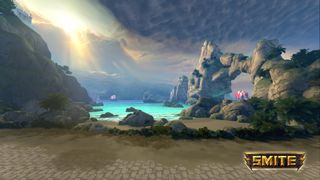
The first Smite World Championship marks the beginning of the game's life as a major e-sport, but is also - it turns out - a swansong for the map currently being used for competitive play. After the tournament, Smite Season 2 will begin in earnest. It's a program of tournaments, updates and new releases that will change the shape of the game over the course of the coming year.
The most significant of these changes is close. In January, an overhauled version of the game's key three-lane Conquest map will be released onto the public test server.
The first thing you'll notice is the extensive work done to expand the scope of the game beyond the playable area. The backdrops for both teams' bases are now far more dramatic. Rather than being painted onto the skybox, Chaos' volcano looms over the battlefield, spilling lava into the playable area. Mount Olympus, likewise, is now less ornamental garden and more Arcadian metropolis - even though the playable space only extends so far, it has a much stronger sense of being a real place.
What has impressed me, checking out the new map for the first time, is how it makes use of Smite's third person camera. You can't do vistas like this in League of Legends or Dota 2 - the new long lane, for example, looks out over a bay patrolled by distant Greek longships. Likewise, the map's special neutral monsters, the Gold Harpy and the Fire Giant, will now make dramatic entrances when they spawn. In the Fire Giant's case, this means fighting his way out of a stone prison. The Harpy, however, flies in from the heights of Olympus passing several other objectives as she goes. You couldn't do that in an isometric game without impacting game balance.
There are, however, a few major changes in the pipeline. Not all of the details are available yet, but there'll be changes to the regular buff camps that sound like they'll make the map slightly more symmetrical - potentially negating the perceived Chaos advantage. 'Leashing', the practise of drawing neutral monsters out of their camps, has been substantially altered also. Resetting a neutral encounter by running away will no longer instantly reset the monsters' health bars. Instead, they'll regen slowly over time. This means that abandoning a Gold Fury attempt risks leaving the job for the enemy team to finish. Crucially, this change will impact every mode that includes neutral monsters.
The new map is due to be available for public testing around the 17th of January.
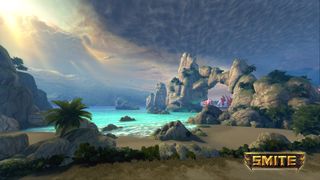
The first Smite World Championship marks the beginning of the game's life as a major e-sport, but is also - it turns out - a swansong for the map currently being used for competitive play. After the tournament, Smite Season 2 will begin in earnest. It's a program of tournaments, updates and new releases that will change the shape of the game over the course of the coming year.
The most significant of these changes is close. In January, an overhauled version of the game's key three-lane Conquest map will be released onto the public test server.
The first thing you'll notice is the extensive work done to expand the scope of the game beyond the playable area. The backdrops for both teams' bases are now far more dramatic. Rather than being painted onto the skybox, Chaos' volcano looms over the battlefield, spilling lava into the playable area. Mount Olympus, likewise, is now less ornamental garden and more Arcadian metropolis - even though the playable space only extends so far, it has a much stronger sense of being a real place.
What has impressed me, checking out the new map for the first time, is how it makes use of Smite's third person camera. You can't do vistas like this in League of Legends or Dota 2 - the new long lane, for example, looks out over a bay patrolled by distant Greek longships. Likewise, the map's special neutral monsters, the Gold Harpy and the Fire Giant, will now make dramatic entrances when they spawn. In the Fire Giant's case, this means fighting his way out of a stone prison. The Harpy, however, flies in from the heights of Olympus passing several other objectives as she goes. You couldn't do that in an isometric game without impacting game balance.
There are, however, a few major changes in the pipeline. Not all of the details are available yet, but there'll be changes to the regular buff camps that sound like they'll make the map slightly more symmetrical - potentially negating the perceived Chaos advantage. 'Leashing', the practise of drawing neutral monsters out of their camps, has been substantially altered also. Resetting a neutral encounter by running away will no longer instantly reset the monsters' health bars. Instead, they'll regen slowly over time. This means that abandoning a Gold Fury attempt risks leaving the job for the enemy team to finish. Crucially, this change will impact every mode that includes neutral monsters.
The new map is due to be available for public testing around the 17th of January.

The first Smite World Championship marks the beginning of the game's life as a major e-sport, but is also - it turns out - a swansong for the map currently being used for competitive play. After the tournament, Smite Season 2 will begin in earnest. It's a program of tournaments, updates and new releases that will change the shape of the game over the course of the coming year.
The most significant of these changes is close. In January, an overhauled version of the game's key three-lane Conquest map will be released onto the public test server.
The first thing you'll notice is the extensive work done to expand the scope of the game beyond the playable area. The backdrops for both teams' bases are now far more dramatic. Rather than being painted onto the skybox, Chaos' volcano looms over the battlefield, spilling lava into the playable area. Mount Olympus, likewise, is now less ornamental garden and more Arcadian metropolis - even though the playable space only extends so far, it has a much stronger sense of being a real place.
What has impressed me, checking out the new map for the first time, is how it makes use of Smite's third person camera. You can't do vistas like this in League of Legends or Dota 2 - the new long lane, for example, looks out over a bay patrolled by distant Greek longships. Likewise, the map's special neutral monsters, the Gold Harpy and the Fire Giant, will now make dramatic entrances when they spawn. In the Fire Giant's case, this means fighting his way out of a stone prison. The Harpy, however, flies in from the heights of Olympus passing several other objectives as she goes. You couldn't do that in an isometric game without impacting game balance.
There are, however, a few major changes in the pipeline. Not all of the details are available yet, but there'll be changes to the regular buff camps that sound like they'll make the map slightly more symmetrical - potentially negating the perceived Chaos advantage. 'Leashing', the practise of drawing neutral monsters out of their camps, has been substantially altered also. Resetting a neutral encounter by running away will no longer instantly reset the monsters' health bars. Instead, they'll regen slowly over time. This means that abandoning a Gold Fury attempt risks leaving the job for the enemy team to finish. Crucially, this change will impact every mode that includes neutral monsters.
The new map is due to be available for public testing around the 17th of January.
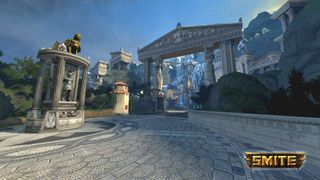
The first Smite World Championship marks the beginning of the game's life as a major e-sport, but is also - it turns out - a swansong for the map currently being used for competitive play. After the tournament, Smite Season 2 will begin in earnest. It's a program of tournaments, updates and new releases that will change the shape of the game over the course of the coming year.
The most significant of these changes is close. In January, an overhauled version of the game's key three-lane Conquest map will be released onto the public test server.
The first thing you'll notice is the extensive work done to expand the scope of the game beyond the playable area. The backdrops for both teams' bases are now far more dramatic. Rather than being painted onto the skybox, Chaos' volcano looms over the battlefield, spilling lava into the playable area. Mount Olympus, likewise, is now less ornamental garden and more Arcadian metropolis - even though the playable space only extends so far, it has a much stronger sense of being a real place.
What has impressed me, checking out the new map for the first time, is how it makes use of Smite's third person camera. You can't do vistas like this in League of Legends or Dota 2 - the new long lane, for example, looks out over a bay patrolled by distant Greek longships. Likewise, the map's special neutral monsters, the Gold Harpy and the Fire Giant, will now make dramatic entrances when they spawn. In the Fire Giant's case, this means fighting his way out of a stone prison. The Harpy, however, flies in from the heights of Olympus passing several other objectives as she goes. You couldn't do that in an isometric game without impacting game balance.
There are, however, a few major changes in the pipeline. Not all of the details are available yet, but there'll be changes to the regular buff camps that sound like they'll make the map slightly more symmetrical - potentially negating the perceived Chaos advantage. 'Leashing', the practise of drawing neutral monsters out of their camps, has been substantially altered also. Resetting a neutral encounter by running away will no longer instantly reset the monsters' health bars. Instead, they'll regen slowly over time. This means that abandoning a Gold Fury attempt risks leaving the job for the enemy team to finish. Crucially, this change will impact every mode that includes neutral monsters.
The new map is due to be available for public testing around the 17th of January.
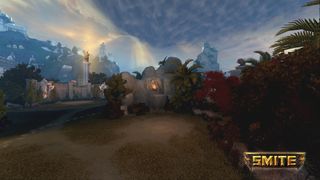
The first Smite World Championship marks the beginning of the game's life as a major e-sport, but is also - it turns out - a swansong for the map currently being used for competitive play. After the tournament, Smite Season 2 will begin in earnest. It's a program of tournaments, updates and new releases that will change the shape of the game over the course of the coming year.
The most significant of these changes is close. In January, an overhauled version of the game's key three-lane Conquest map will be released onto the public test server.
The first thing you'll notice is the extensive work done to expand the scope of the game beyond the playable area. The backdrops for both teams' bases are now far more dramatic. Rather than being painted onto the skybox, Chaos' volcano looms over the battlefield, spilling lava into the playable area. Mount Olympus, likewise, is now less ornamental garden and more Arcadian metropolis - even though the playable space only extends so far, it has a much stronger sense of being a real place.
What has impressed me, checking out the new map for the first time, is how it makes use of Smite's third person camera. You can't do vistas like this in League of Legends or Dota 2 - the new long lane, for example, looks out over a bay patrolled by distant Greek longships. Likewise, the map's special neutral monsters, the Gold Harpy and the Fire Giant, will now make dramatic entrances when they spawn. In the Fire Giant's case, this means fighting his way out of a stone prison. The Harpy, however, flies in from the heights of Olympus passing several other objectives as she goes. You couldn't do that in an isometric game without impacting game balance.
There are, however, a few major changes in the pipeline. Not all of the details are available yet, but there'll be changes to the regular buff camps that sound like they'll make the map slightly more symmetrical - potentially negating the perceived Chaos advantage. 'Leashing', the practise of drawing neutral monsters out of their camps, has been substantially altered also. Resetting a neutral encounter by running away will no longer instantly reset the monsters' health bars. Instead, they'll regen slowly over time. This means that abandoning a Gold Fury attempt risks leaving the job for the enemy team to finish. Crucially, this change will impact every mode that includes neutral monsters.
The new map is due to be available for public testing around the 17th of January.

The first Smite World Championship marks the beginning of the game's life as a major e-sport, but is also - it turns out - a swansong for the map currently being used for competitive play. After the tournament, Smite Season 2 will begin in earnest. It's a program of tournaments, updates and new releases that will change the shape of the game over the course of the coming year.
The most significant of these changes is close. In January, an overhauled version of the game's key three-lane Conquest map will be released onto the public test server.
The first thing you'll notice is the extensive work done to expand the scope of the game beyond the playable area. The backdrops for both teams' bases are now far more dramatic. Rather than being painted onto the skybox, Chaos' volcano looms over the battlefield, spilling lava into the playable area. Mount Olympus, likewise, is now less ornamental garden and more Arcadian metropolis - even though the playable space only extends so far, it has a much stronger sense of being a real place.
What has impressed me, checking out the new map for the first time, is how it makes use of Smite's third person camera. You can't do vistas like this in League of Legends or Dota 2 - the new long lane, for example, looks out over a bay patrolled by distant Greek longships. Likewise, the map's special neutral monsters, the Gold Harpy and the Fire Giant, will now make dramatic entrances when they spawn. In the Fire Giant's case, this means fighting his way out of a stone prison. The Harpy, however, flies in from the heights of Olympus passing several other objectives as she goes. You couldn't do that in an isometric game without impacting game balance.
There are, however, a few major changes in the pipeline. Not all of the details are available yet, but there'll be changes to the regular buff camps that sound like they'll make the map slightly more symmetrical - potentially negating the perceived Chaos advantage. 'Leashing', the practise of drawing neutral monsters out of their camps, has been substantially altered also. Resetting a neutral encounter by running away will no longer instantly reset the monsters' health bars. Instead, they'll regen slowly over time. This means that abandoning a Gold Fury attempt risks leaving the job for the enemy team to finish. Crucially, this change will impact every mode that includes neutral monsters.
The new map is due to be available for public testing around the 17th of January.
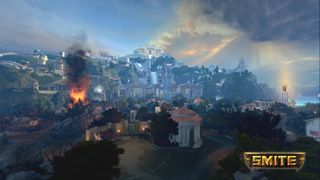
The first Smite World Championship marks the beginning of the game's life as a major e-sport, but is also - it turns out - a swansong for the map currently being used for competitive play. After the tournament, Smite Season 2 will begin in earnest. It's a program of tournaments, updates and new releases that will change the shape of the game over the course of the coming year.
The most significant of these changes is close. In January, an overhauled version of the game's key three-lane Conquest map will be released onto the public test server.
The first thing you'll notice is the extensive work done to expand the scope of the game beyond the playable area. The backdrops for both teams' bases are now far more dramatic. Rather than being painted onto the skybox, Chaos' volcano looms over the battlefield, spilling lava into the playable area. Mount Olympus, likewise, is now less ornamental garden and more Arcadian metropolis - even though the playable space only extends so far, it has a much stronger sense of being a real place.
What has impressed me, checking out the new map for the first time, is how it makes use of Smite's third person camera. You can't do vistas like this in League of Legends or Dota 2 - the new long lane, for example, looks out over a bay patrolled by distant Greek longships. Likewise, the map's special neutral monsters, the Gold Harpy and the Fire Giant, will now make dramatic entrances when they spawn. In the Fire Giant's case, this means fighting his way out of a stone prison. The Harpy, however, flies in from the heights of Olympus passing several other objectives as she goes. You couldn't do that in an isometric game without impacting game balance.
There are, however, a few major changes in the pipeline. Not all of the details are available yet, but there'll be changes to the regular buff camps that sound like they'll make the map slightly more symmetrical - potentially negating the perceived Chaos advantage. 'Leashing', the practise of drawing neutral monsters out of their camps, has been substantially altered also. Resetting a neutral encounter by running away will no longer instantly reset the monsters' health bars. Instead, they'll regen slowly over time. This means that abandoning a Gold Fury attempt risks leaving the job for the enemy team to finish. Crucially, this change will impact every mode that includes neutral monsters.
The new map is due to be available for public testing around the 17th of January.

The first Smite World Championship marks the beginning of the game's life as a major e-sport, but is also - it turns out - a swansong for the map currently being used for competitive play. After the tournament, Smite Season 2 will begin in earnest. It's a program of tournaments, updates and new releases that will change the shape of the game over the course of the coming year.
The most significant of these changes is close. In January, an overhauled version of the game's key three-lane Conquest map will be released onto the public test server.
The first thing you'll notice is the extensive work done to expand the scope of the game beyond the playable area. The backdrops for both teams' bases are now far more dramatic. Rather than being painted onto the skybox, Chaos' volcano looms over the battlefield, spilling lava into the playable area. Mount Olympus, likewise, is now less ornamental garden and more Arcadian metropolis - even though the playable space only extends so far, it has a much stronger sense of being a real place.
What has impressed me, checking out the new map for the first time, is how it makes use of Smite's third person camera. You can't do vistas like this in League of Legends or Dota 2 - the new long lane, for example, looks out over a bay patrolled by distant Greek longships. Likewise, the map's special neutral monsters, the Gold Harpy and the Fire Giant, will now make dramatic entrances when they spawn. In the Fire Giant's case, this means fighting his way out of a stone prison. The Harpy, however, flies in from the heights of Olympus passing several other objectives as she goes. You couldn't do that in an isometric game without impacting game balance.
There are, however, a few major changes in the pipeline. Not all of the details are available yet, but there'll be changes to the regular buff camps that sound like they'll make the map slightly more symmetrical - potentially negating the perceived Chaos advantage. 'Leashing', the practise of drawing neutral monsters out of their camps, has been substantially altered also. Resetting a neutral encounter by running away will no longer instantly reset the monsters' health bars. Instead, they'll regen slowly over time. This means that abandoning a Gold Fury attempt risks leaving the job for the enemy team to finish. Crucially, this change will impact every mode that includes neutral monsters.
The new map is due to be available for public testing around the 17th of January.
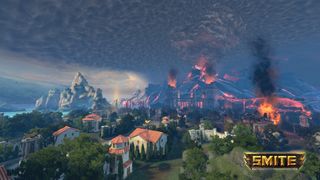
The first Smite World Championship marks the beginning of the game's life as a major e-sport, but is also - it turns out - a swansong for the map currently being used for competitive play. After the tournament, Smite Season 2 will begin in earnest. It's a program of tournaments, updates and new releases that will change the shape of the game over the course of the coming year.
The most significant of these changes is close. In January, an overhauled version of the game's key three-lane Conquest map will be released onto the public test server.
The first thing you'll notice is the extensive work done to expand the scope of the game beyond the playable area. The backdrops for both teams' bases are now far more dramatic. Rather than being painted onto the skybox, Chaos' volcano looms over the battlefield, spilling lava into the playable area. Mount Olympus, likewise, is now less ornamental garden and more Arcadian metropolis - even though the playable space only extends so far, it has a much stronger sense of being a real place.
What has impressed me, checking out the new map for the first time, is how it makes use of Smite's third person camera. You can't do vistas like this in League of Legends or Dota 2 - the new long lane, for example, looks out over a bay patrolled by distant Greek longships. Likewise, the map's special neutral monsters, the Gold Harpy and the Fire Giant, will now make dramatic entrances when they spawn. In the Fire Giant's case, this means fighting his way out of a stone prison. The Harpy, however, flies in from the heights of Olympus passing several other objectives as she goes. You couldn't do that in an isometric game without impacting game balance.
There are, however, a few major changes in the pipeline. Not all of the details are available yet, but there'll be changes to the regular buff camps that sound like they'll make the map slightly more symmetrical - potentially negating the perceived Chaos advantage. 'Leashing', the practise of drawing neutral monsters out of their camps, has been substantially altered also. Resetting a neutral encounter by running away will no longer instantly reset the monsters' health bars. Instead, they'll regen slowly over time. This means that abandoning a Gold Fury attempt risks leaving the job for the enemy team to finish. Crucially, this change will impact every mode that includes neutral monsters.
The new map is due to be available for public testing around the 17th of January.
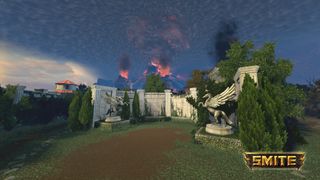
The first Smite World Championship marks the beginning of the game's life as a major e-sport, but is also - it turns out - a swansong for the map currently being used for competitive play. After the tournament, Smite Season 2 will begin in earnest. It's a program of tournaments, updates and new releases that will change the shape of the game over the course of the coming year.
The most significant of these changes is close. In January, an overhauled version of the game's key three-lane Conquest map will be released onto the public test server.
The first thing you'll notice is the extensive work done to expand the scope of the game beyond the playable area. The backdrops for both teams' bases are now far more dramatic. Rather than being painted onto the skybox, Chaos' volcano looms over the battlefield, spilling lava into the playable area. Mount Olympus, likewise, is now less ornamental garden and more Arcadian metropolis - even though the playable space only extends so far, it has a much stronger sense of being a real place.
What has impressed me, checking out the new map for the first time, is how it makes use of Smite's third person camera. You can't do vistas like this in League of Legends or Dota 2 - the new long lane, for example, looks out over a bay patrolled by distant Greek longships. Likewise, the map's special neutral monsters, the Gold Harpy and the Fire Giant, will now make dramatic entrances when they spawn. In the Fire Giant's case, this means fighting his way out of a stone prison. The Harpy, however, flies in from the heights of Olympus passing several other objectives as she goes. You couldn't do that in an isometric game without impacting game balance.
There are, however, a few major changes in the pipeline. Not all of the details are available yet, but there'll be changes to the regular buff camps that sound like they'll make the map slightly more symmetrical - potentially negating the perceived Chaos advantage. 'Leashing', the practise of drawing neutral monsters out of their camps, has been substantially altered also. Resetting a neutral encounter by running away will no longer instantly reset the monsters' health bars. Instead, they'll regen slowly over time. This means that abandoning a Gold Fury attempt risks leaving the job for the enemy team to finish. Crucially, this change will impact every mode that includes neutral monsters.
The new map is due to be available for public testing around the 17th of January.

The first Smite World Championship marks the beginning of the game's life as a major e-sport, but is also - it turns out - a swansong for the map currently being used for competitive play. After the tournament, Smite Season 2 will begin in earnest. It's a program of tournaments, updates and new releases that will change the shape of the game over the course of the coming year.
The most significant of these changes is close. In January, an overhauled version of the game's key three-lane Conquest map will be released onto the public test server.
The first thing you'll notice is the extensive work done to expand the scope of the game beyond the playable area. The backdrops for both teams' bases are now far more dramatic. Rather than being painted onto the skybox, Chaos' volcano looms over the battlefield, spilling lava into the playable area. Mount Olympus, likewise, is now less ornamental garden and more Arcadian metropolis - even though the playable space only extends so far, it has a much stronger sense of being a real place.
What has impressed me, checking out the new map for the first time, is how it makes use of Smite's third person camera. You can't do vistas like this in League of Legends or Dota 2 - the new long lane, for example, looks out over a bay patrolled by distant Greek longships. Likewise, the map's special neutral monsters, the Gold Harpy and the Fire Giant, will now make dramatic entrances when they spawn. In the Fire Giant's case, this means fighting his way out of a stone prison. The Harpy, however, flies in from the heights of Olympus passing several other objectives as she goes. You couldn't do that in an isometric game without impacting game balance.
There are, however, a few major changes in the pipeline. Not all of the details are available yet, but there'll be changes to the regular buff camps that sound like they'll make the map slightly more symmetrical - potentially negating the perceived Chaos advantage. 'Leashing', the practise of drawing neutral monsters out of their camps, has been substantially altered also. Resetting a neutral encounter by running away will no longer instantly reset the monsters' health bars. Instead, they'll regen slowly over time. This means that abandoning a Gold Fury attempt risks leaving the job for the enemy team to finish. Crucially, this change will impact every mode that includes neutral monsters.
The new map is due to be available for public testing around the 17th of January.

The first Smite World Championship marks the beginning of the game's life as a major e-sport, but is also - it turns out - a swansong for the map currently being used for competitive play. After the tournament, Smite Season 2 will begin in earnest. It's a program of tournaments, updates and new releases that will change the shape of the game over the course of the coming year.
The most significant of these changes is close. In January, an overhauled version of the game's key three-lane Conquest map will be released onto the public test server.
The first thing you'll notice is the extensive work done to expand the scope of the game beyond the playable area. The backdrops for both teams' bases are now far more dramatic. Rather than being painted onto the skybox, Chaos' volcano looms over the battlefield, spilling lava into the playable area. Mount Olympus, likewise, is now less ornamental garden and more Arcadian metropolis - even though the playable space only extends so far, it has a much stronger sense of being a real place.
What has impressed me, checking out the new map for the first time, is how it makes use of Smite's third person camera. You can't do vistas like this in League of Legends or Dota 2 - the new long lane, for example, looks out over a bay patrolled by distant Greek longships. Likewise, the map's special neutral monsters, the Gold Harpy and the Fire Giant, will now make dramatic entrances when they spawn. In the Fire Giant's case, this means fighting his way out of a stone prison. The Harpy, however, flies in from the heights of Olympus passing several other objectives as she goes. You couldn't do that in an isometric game without impacting game balance.
There are, however, a few major changes in the pipeline. Not all of the details are available yet, but there'll be changes to the regular buff camps that sound like they'll make the map slightly more symmetrical - potentially negating the perceived Chaos advantage. 'Leashing', the practise of drawing neutral monsters out of their camps, has been substantially altered also. Resetting a neutral encounter by running away will no longer instantly reset the monsters' health bars. Instead, they'll regen slowly over time. This means that abandoning a Gold Fury attempt risks leaving the job for the enemy team to finish. Crucially, this change will impact every mode that includes neutral monsters.
The new map is due to be available for public testing around the 17th of January.
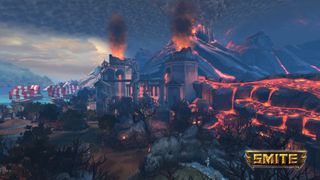
The first Smite World Championship marks the beginning of the game's life as a major e-sport, but is also - it turns out - a swansong for the map currently being used for competitive play. After the tournament, Smite Season 2 will begin in earnest. It's a program of tournaments, updates and new releases that will change the shape of the game over the course of the coming year.
The most significant of these changes is close. In January, an overhauled version of the game's key three-lane Conquest map will be released onto the public test server.
The first thing you'll notice is the extensive work done to expand the scope of the game beyond the playable area. The backdrops for both teams' bases are now far more dramatic. Rather than being painted onto the skybox, Chaos' volcano looms over the battlefield, spilling lava into the playable area. Mount Olympus, likewise, is now less ornamental garden and more Arcadian metropolis - even though the playable space only extends so far, it has a much stronger sense of being a real place.
What has impressed me, checking out the new map for the first time, is how it makes use of Smite's third person camera. You can't do vistas like this in League of Legends or Dota 2 - the new long lane, for example, looks out over a bay patrolled by distant Greek longships. Likewise, the map's special neutral monsters, the Gold Harpy and the Fire Giant, will now make dramatic entrances when they spawn. In the Fire Giant's case, this means fighting his way out of a stone prison. The Harpy, however, flies in from the heights of Olympus passing several other objectives as she goes. You couldn't do that in an isometric game without impacting game balance.
There are, however, a few major changes in the pipeline. Not all of the details are available yet, but there'll be changes to the regular buff camps that sound like they'll make the map slightly more symmetrical - potentially negating the perceived Chaos advantage. 'Leashing', the practise of drawing neutral monsters out of their camps, has been substantially altered also. Resetting a neutral encounter by running away will no longer instantly reset the monsters' health bars. Instead, they'll regen slowly over time. This means that abandoning a Gold Fury attempt risks leaving the job for the enemy team to finish. Crucially, this change will impact every mode that includes neutral monsters.
The new map is due to be available for public testing around the 17th of January.
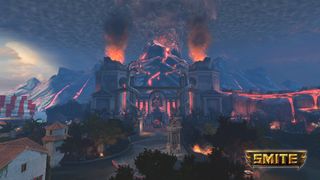
The first Smite World Championship marks the beginning of the game's life as a major e-sport, but is also - it turns out - a swansong for the map currently being used for competitive play. After the tournament, Smite Season 2 will begin in earnest. It's a program of tournaments, updates and new releases that will change the shape of the game over the course of the coming year.
The most significant of these changes is close. In January, an overhauled version of the game's key three-lane Conquest map will be released onto the public test server.
The first thing you'll notice is the extensive work done to expand the scope of the game beyond the playable area. The backdrops for both teams' bases are now far more dramatic. Rather than being painted onto the skybox, Chaos' volcano looms over the battlefield, spilling lava into the playable area. Mount Olympus, likewise, is now less ornamental garden and more Arcadian metropolis - even though the playable space only extends so far, it has a much stronger sense of being a real place.
What has impressed me, checking out the new map for the first time, is how it makes use of Smite's third person camera. You can't do vistas like this in League of Legends or Dota 2 - the new long lane, for example, looks out over a bay patrolled by distant Greek longships. Likewise, the map's special neutral monsters, the Gold Harpy and the Fire Giant, will now make dramatic entrances when they spawn. In the Fire Giant's case, this means fighting his way out of a stone prison. The Harpy, however, flies in from the heights of Olympus passing several other objectives as she goes. You couldn't do that in an isometric game without impacting game balance.
There are, however, a few major changes in the pipeline. Not all of the details are available yet, but there'll be changes to the regular buff camps that sound like they'll make the map slightly more symmetrical - potentially negating the perceived Chaos advantage. 'Leashing', the practise of drawing neutral monsters out of their camps, has been substantially altered also. Resetting a neutral encounter by running away will no longer instantly reset the monsters' health bars. Instead, they'll regen slowly over time. This means that abandoning a Gold Fury attempt risks leaving the job for the enemy team to finish. Crucially, this change will impact every mode that includes neutral monsters.
The new map is due to be available for public testing around the 17th of January.
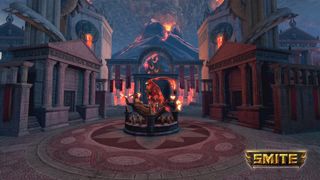
The first Smite World Championship marks the beginning of the game's life as a major e-sport, but is also - it turns out - a swansong for the map currently being used for competitive play. After the tournament, Smite Season 2 will begin in earnest. It's a program of tournaments, updates and new releases that will change the shape of the game over the course of the coming year.
The most significant of these changes is close. In January, an overhauled version of the game's key three-lane Conquest map will be released onto the public test server.
The first thing you'll notice is the extensive work done to expand the scope of the game beyond the playable area. The backdrops for both teams' bases are now far more dramatic. Rather than being painted onto the skybox, Chaos' volcano looms over the battlefield, spilling lava into the playable area. Mount Olympus, likewise, is now less ornamental garden and more Arcadian metropolis - even though the playable space only extends so far, it has a much stronger sense of being a real place.
What has impressed me, checking out the new map for the first time, is how it makes use of Smite's third person camera. You can't do vistas like this in League of Legends or Dota 2 - the new long lane, for example, looks out over a bay patrolled by distant Greek longships. Likewise, the map's special neutral monsters, the Gold Harpy and the Fire Giant, will now make dramatic entrances when they spawn. In the Fire Giant's case, this means fighting his way out of a stone prison. The Harpy, however, flies in from the heights of Olympus passing several other objectives as she goes. You couldn't do that in an isometric game without impacting game balance.
There are, however, a few major changes in the pipeline. Not all of the details are available yet, but there'll be changes to the regular buff camps that sound like they'll make the map slightly more symmetrical - potentially negating the perceived Chaos advantage. 'Leashing', the practise of drawing neutral monsters out of their camps, has been substantially altered also. Resetting a neutral encounter by running away will no longer instantly reset the monsters' health bars. Instead, they'll regen slowly over time. This means that abandoning a Gold Fury attempt risks leaving the job for the enemy team to finish. Crucially, this change will impact every mode that includes neutral monsters.
The new map is due to be available for public testing around the 17th of January.
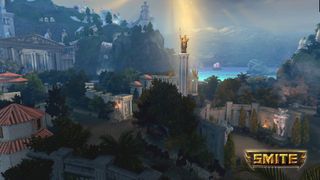
The first Smite World Championship marks the beginning of the game's life as a major e-sport, but is also - it turns out - a swansong for the map currently being used for competitive play. After the tournament, Smite Season 2 will begin in earnest. It's a program of tournaments, updates and new releases that will change the shape of the game over the course of the coming year.
The most significant of these changes is close. In January, an overhauled version of the game's key three-lane Conquest map will be released onto the public test server.
The first thing you'll notice is the extensive work done to expand the scope of the game beyond the playable area. The backdrops for both teams' bases are now far more dramatic. Rather than being painted onto the skybox, Chaos' volcano looms over the battlefield, spilling lava into the playable area. Mount Olympus, likewise, is now less ornamental garden and more Arcadian metropolis - even though the playable space only extends so far, it has a much stronger sense of being a real place.
What has impressed me, checking out the new map for the first time, is how it makes use of Smite's third person camera. You can't do vistas like this in League of Legends or Dota 2 - the new long lane, for example, looks out over a bay patrolled by distant Greek longships. Likewise, the map's special neutral monsters, the Gold Harpy and the Fire Giant, will now make dramatic entrances when they spawn. In the Fire Giant's case, this means fighting his way out of a stone prison. The Harpy, however, flies in from the heights of Olympus passing several other objectives as she goes. You couldn't do that in an isometric game without impacting game balance.
There are, however, a few major changes in the pipeline. Not all of the details are available yet, but there'll be changes to the regular buff camps that sound like they'll make the map slightly more symmetrical - potentially negating the perceived Chaos advantage. 'Leashing', the practise of drawing neutral monsters out of their camps, has been substantially altered also. Resetting a neutral encounter by running away will no longer instantly reset the monsters' health bars. Instead, they'll regen slowly over time. This means that abandoning a Gold Fury attempt risks leaving the job for the enemy team to finish. Crucially, this change will impact every mode that includes neutral monsters.
The new map is due to be available for public testing around the 17th of January.
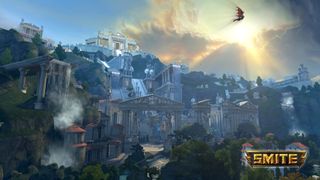
The first Smite World Championship marks the beginning of the game's life as a major e-sport, but is also - it turns out - a swansong for the map currently being used for competitive play. After the tournament, Smite Season 2 will begin in earnest. It's a program of tournaments, updates and new releases that will change the shape of the game over the course of the coming year.
The most significant of these changes is close. In January, an overhauled version of the game's key three-lane Conquest map will be released onto the public test server.
The first thing you'll notice is the extensive work done to expand the scope of the game beyond the playable area. The backdrops for both teams' bases are now far more dramatic. Rather than being painted onto the skybox, Chaos' volcano looms over the battlefield, spilling lava into the playable area. Mount Olympus, likewise, is now less ornamental garden and more Arcadian metropolis - even though the playable space only extends so far, it has a much stronger sense of being a real place.
What has impressed me, checking out the new map for the first time, is how it makes use of Smite's third person camera. You can't do vistas like this in League of Legends or Dota 2 - the new long lane, for example, looks out over a bay patrolled by distant Greek longships. Likewise, the map's special neutral monsters, the Gold Harpy and the Fire Giant, will now make dramatic entrances when they spawn. In the Fire Giant's case, this means fighting his way out of a stone prison. The Harpy, however, flies in from the heights of Olympus passing several other objectives as she goes. You couldn't do that in an isometric game without impacting game balance.
There are, however, a few major changes in the pipeline. Not all of the details are available yet, but there'll be changes to the regular buff camps that sound like they'll make the map slightly more symmetrical - potentially negating the perceived Chaos advantage. 'Leashing', the practise of drawing neutral monsters out of their camps, has been substantially altered also. Resetting a neutral encounter by running away will no longer instantly reset the monsters' health bars. Instead, they'll regen slowly over time. This means that abandoning a Gold Fury attempt risks leaving the job for the enemy team to finish. Crucially, this change will impact every mode that includes neutral monsters.
The new map is due to be available for public testing around the 17th of January.

Joining in 2011, Chris made his start with PC Gamer turning beautiful trees into magazines, first as a writer and later as deputy editor. Once PCG's reluctant MMO champion , his discovery of Dota 2 in 2012 led him to much darker, stranger places. In 2015, Chris became the editor of PC Gamer Pro, overseeing our online coverage of competitive gaming and esports. He left in 2017, and can be now found making games and recording the Crate & Crowbar podcast.
Most Popular

